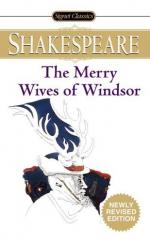|
This section contains 4,918 words (approx. 17 pages at 300 words per page) |

|
SOURCE: "Falstaff as a Woman," in Journal of Dramatic Theory and Criticism, Vol. X, No. 1, Fall, 1995, pp. 31-41.
In the essay below, originally presented in 1989, Moss argues that the figure of Falstaff disguised as a woman is a symbol of our own childlike need for play through dressing up and "theatricality."
My concern is with the moment in Act 4, scene 2, of the Merry Wives of Windsor where Falstaff escapes from the Ford household disguised as a woman. As well as the general interest that cross-dressing gives rise to as a defining characteristic of Elizabethan comedy, the special interest of this moment is that it is the only instance in Shakespeare's plays where a male character adopts female disguise. And not just any male character, but the most fully-formed of his comic creations, and the completest embodiment of his idea of comedy.
Beyond this, it has to be said...
|
This section contains 4,918 words (approx. 17 pages at 300 words per page) |

|


